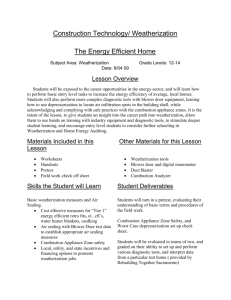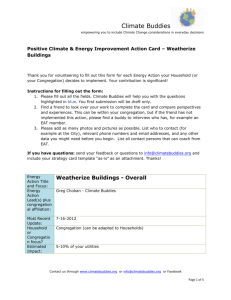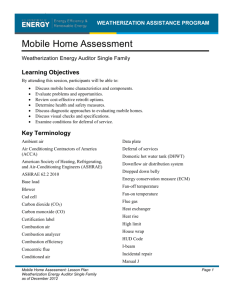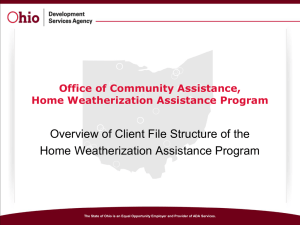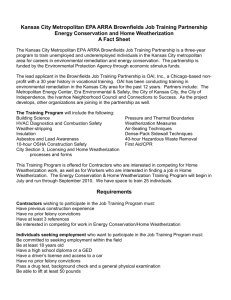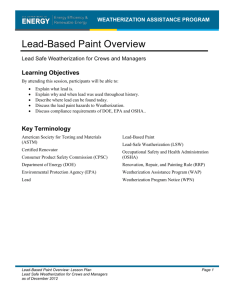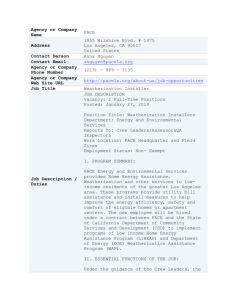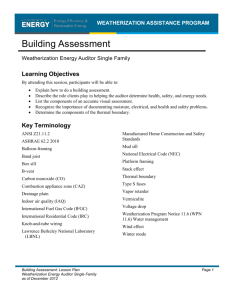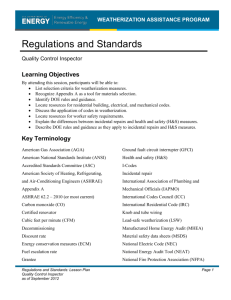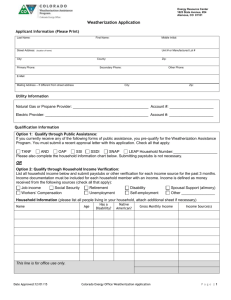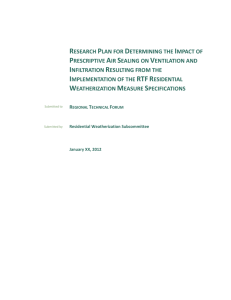Weatherization 301
advertisement
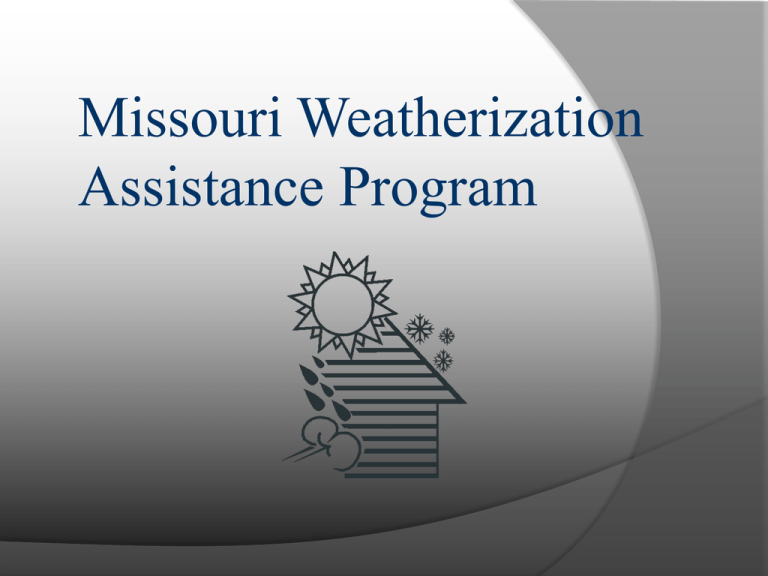
Missouri Weatherization Assistance Program Missouri Weatherization Program Mission Reduce the energy burden on Lowincome residents by installing cost effective energy efficiency measures, while ensuring their health and safety Benefits to Missourians Reduces energy usage Makes housing more affordable Increases efficiency of existing housing Alleviates substandard living conditions and reduces risk of homelessness Provides a safer, healthier living environment Where is Weatherization ? What Homes Can Be Weatherized? Services delivered to single-family, multifamily, and mobile homes Program Funding U.S. Department of Energy (DOE) ○ Administered by Missouri Department of Natural Resources Division of Energy Other Sources of Weatherization Program Funding ○ ○ ○ ○ ○ Utility companies State and Federal housing program partnerships Leverage additional private resources A portion of the estimated costs required by landlord Missouri may transfer up to 15% of LIHEAP funds directly to the Weatherization Program ○ 0% of LIHEAP funds are currently transferred to the Weatherization Program Why Weatherization? Heavy energy burden on low-income Typically spend 14.4% of annual income on energy, compared with 3.3% for other households Source: http://www.waptac.org/data/files/transcripts/transcripts_216.pdf Weatherization lowers the incidence of arrearages and disconnects Low-income families choose between heat and other necessities 445,888 low-income households in Missouri Source: US Census Data Weatherization Benefits Increases home energy efficiency Safe and healthy living environment Permanent energy solution Reduces arrearages, lessens destructive cycle of shut-offs and re-connections Economic development Weatherization Benefits Average annual energy savings = $437 Returns $2.51 to the household and society for every $1 invested Decreases national energy consumption by the equivalent of $24.1 million Reduces demand on the electric grid Reduces need to build more power plants www.waptac.org Percent of LIHEAP Funding Designated for Weatherization Services (Source: LIHEAP Clearinghouse) State FY Percent of LIHEAP Funds for Weatherization Arkansas 2011 15% Iowa 2011 15% Illinois 2011 15% Kansas 2011 15% Colorado 2011 15% Missouri 2011 0% Nebraska 2011 11% Oklahoma 2011 2% Texas 2011 15% LIHEAP Funding FY 2011 $45 million in FY 2012 15% to Weatherization equates to: $6.75 million for Weatherization 1,300 homes weatherized Potentially 100 direct jobs maintained Additional job creation for contractors and local suppliers Weatherization Process Application Submitted Energy audit conducted Health and Safety concerns addressed Client energy education Work order completed Energy efficiency measures installed Post-work inspection completed Weatherization Income Guidelines Household Size 1 2 3 4 5 Maximum Income $21,780 $29,420 $37,060 $44,700 $52,340 Eligibility Determination Priority groups Elderly, disabled, family with children, household with high energy burden Renters Landlord must approve A portion of the estimated costs are required from landlord (not required if income eligible) Energy Audit Energy auditors inspect the home and determine energy efficiency, and health and safety measures Building Performance Institute (BPI) Certification maintained to safely perform weatherization Combustion analysis Nationally recognized Diagnostic tools Improve identifying energy problems and health and safety concerns. ○ ○ ○ ○ Carbon Monoxide Gas leaks Moisture Leakage and heat loss Energy Audit Software National Energy Audit (NEAT) and Mobile Home Energy Audit (MHEA) Determines the most cost effective energy measures for each individual home Savings to investment ratio (SIR) $1 or greater Developed and maintained by Oak Ridge National Laboratory Diagnostic Tools Blower door De-pressurizes home Identifies and measures air leakage rate of home Diagnostic Tools DG-700 Indicates level of air leakage Used to locate leaks Diagnostic Tools Pressure Pan Leaky ducts can increase utility costs by 10-30% While the blower door runs, pressure pan is placed over air registers to determine duct leakage Diagnostic Tools Duct Blaster Measures duct leakage Results help locate large leaks Leaks to the outside Diagnostic Tools Infrared Camera Identifies heat loss Guides air sealing and insulation Helps to educate clients Quality control for insulation and other measures Diagnostic Tools Combustion Analyzer Efficiency and safety Composition of flue gases Indicates inefficient combustion, hazardous byproducts (e.g., carbon monoxide) Diagnostic Tools Gas Leak Detector Identifies combustible gas leaks Important health and safety test Saves lives, fuel, and money Effective tool for client education Dangers of Back Drafting Draws flue-gases and toxins into home Makes occupants sick Can be fatal Identifying Back Drafting Identify conditions causing combustion appliances to exhaust flue gases back into a home Worst Case Testing Conducted Creating greatest depressurization to combustion appliances ○ Exhaust fans, dryer, furnace fan, etc. ○ Opening or closing house room doors (depending on pressure impact to combustion appliance zone Energy Efficiency Measures Blower Door Guided Air-Sealing Locates air leaks Indicates when “optimal” air-sealing is achieved ○ Visual inspections may miss “hidden” air leaks and bypasses through floors, sealed fireplaces, cabinets Auditors are trained to air seal without harming indoor air quality ○ Minimum ventilation requirements Energy Efficiency Measures Insulation Attic, floors, and walls Energy Efficiency Measures: Insulation Blown insulation most effective Reduces air infiltration Increases thermal resistance Energy Efficiency Measure: Duct Sealing and Insulation Duct Sealing and Insulation Duct system may need sealing and/or balancing Apply approved tape and mastic Ducts in unconditioned spaces are insulated Energy Efficiency Measures Heating System May need tune-up or basic repairs Can replace dangerous or inoperable furnaces Can replace furnaces for efficiency Unvented space heaters must only be used as a secondary heat source in site built homes Energy Efficiency Measures Base Load Reduction Electricity consumption can be reduced through lighting, refrigerator, water saving measures, and water heater measures Equipment may need tuning Energy Efficiency Measures Base Load Reduction Wrap water heater tank and pipes Install programmable thermostat Health and Safety Pre and post inspection of home Conduct weatherization in a lead-safe manner Check for carbon monoxide, gas leaks, moisture/mold, electrical hazards Ensure safety of clients Health and Safety Measures Before Combustion Appliances Technicians test all gas furnaces, water heaters, cook stoves and dryers All safety problems are addressed After Client Education Client education is a critical component, and is conducted before and after measures are installed Ensure savings Prevent health hazards Prolong life of measures, appliances, and client Post-Work Inspection Blower door test ensures quality air sealing Combustion Appliance Zone (CAZ) testing Indicates adequate combustion air and proper combustion appliance drafting Insulation and other measures checked for quality and completion Success Stories • Before weatherization, Mrs. S.T.’s heating system was vented improperly and unsafe. • Local Sub-contractor did repairs. • Carbon Monoxide (CO) & smoke alarms were installed. • Insulation measures were installed. • Combustible appliances were rechecked & determined safe, completed Weatherization measures. • Air Infiltration Rate (before) 16,100 CFM (after) 3,781 CFM. Reduction of 12,319 CFM. Success Stories During Ms. D.C.’s client interview we discovered that her home had a 50+ year old furnace. During the audit we found a crack in the heat exchanger, exposed wiring & high CO levels. Weatherization replaced furnace, installed chimney liner & attic insulation. She stated high utility (gas & electric) bills; down by about half (1/2) since work was completed. Home stays cooler in summer with less A/C costs. Success Stories At Ms. D.W.’s interview her statement was “My home is in horrible shape.” “I have to put comforters over the doors so we will not freeze in the winter.” Weatherization work completed by local St. Louis County CAA. Work included attic & floor insulation, air sealing measures and CO & smoke alarms installed. She stated she is now able to participate in budget billing for her home heating fuel. Her electric was about $500 a month during summer and is now averaging $280 a month since Weatherization services were provided. Weatherization Works! For Families For Communities For Missourians
